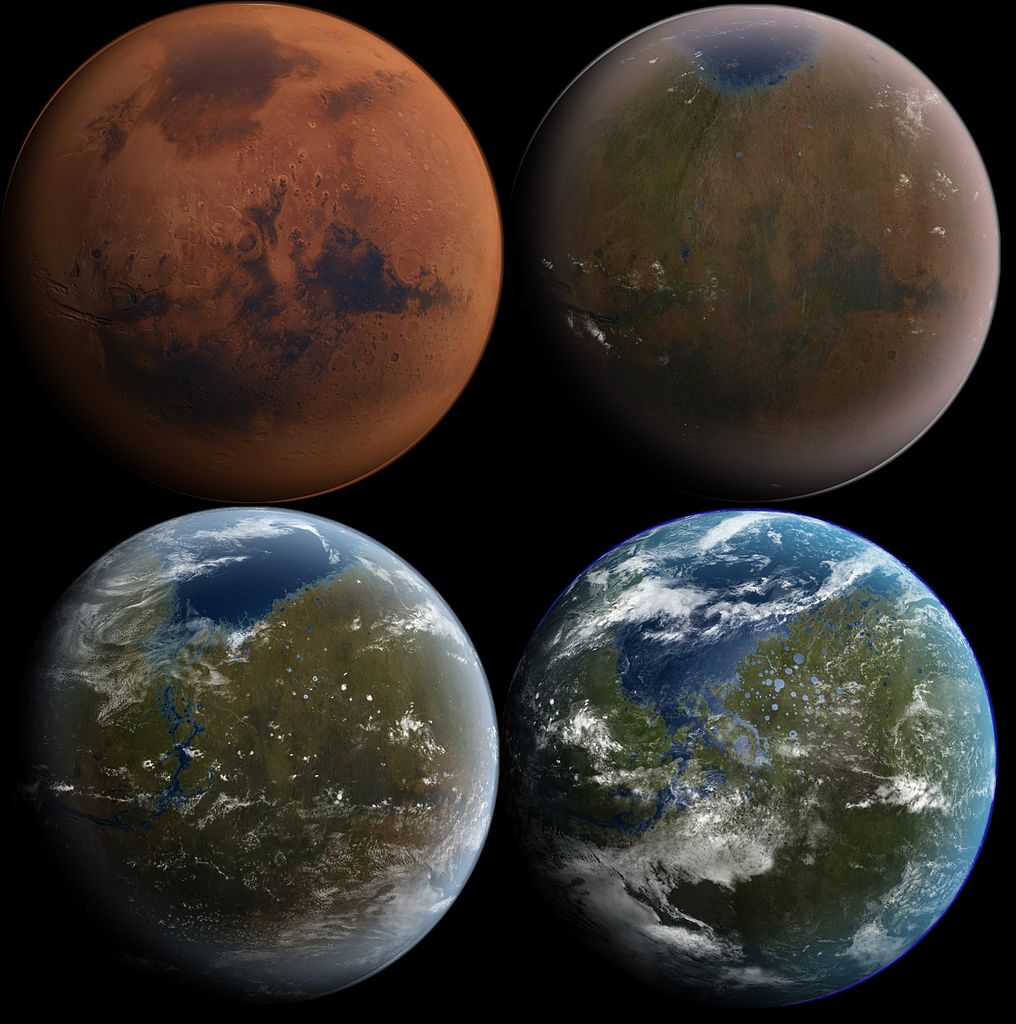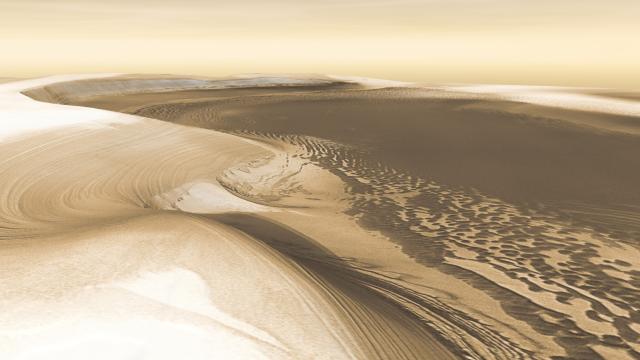Terraforming Mars could be our only option once we screw this planet up beyond repair, but how exactly are we going to do it? One popular scheme involves releasing truckloads of nuclear warheads over the poles, unlocking billions of tonnes of frozen carbon dioxide and triggering a runaway greenhouse.
Chasma Boreale and north polar ice cap of Mars. Image Credit: NASA/JPL/Arizona State University, R. Luk
But if sending your kids to live on extraterrestrial Chernobyl sounds unappealing, good news. There may be a more pacifistic way to warm up Mars — by giving it a cloudy sky.
Mars today is a frozen desert, but ancient riverbeds hint at a much warmer, wetter and more vibrant past. How exactly the Red Planet could have maintained an Earth-like climate 3.8 billion years ago is something of a mystery, however, given that ancient Mars only received 75 per cent of the solar radiation that modern Mars does. This translates to roughly a third of the sunlight modern Earth enjoys — and yet, somehow, it was enough to keep temperatures above freezing.
According to a modelling paper accepted for publication in Icarus, a layer of high-altitude clouds might have helped. If correct, that hypothesis could point to new strategies for making Mars habitable once again, in the future.
“I think everybody is pretty much in agreement on one thing: CO2 and water vapour were not enough to heat Mars up to the melting point of ice,” lead study author Ramses Ramirez told Gizmodo. “To be warm enough to support liquid water on the surface, the atmosphere probably needed some supplementary gases or clouds. Perhaps both.”
While most researchers assume that Mars’ air contained CO2 and water vapour 3.8 billion years ago, it’s been suggested that other gases, including sulfate (SO2), methane (CH4) and dihydrogen (H2) could have influenced the climate as well. Still, models that rely on greenhouse gases alone have have trouble producing stable, warm climates on Mars over the long term. A growing number of astrobiologists are now turning to alternate explanations.
One of those explanations involves clouds. “Clouds absorb and reflect radiation,” Ramirez said. “Depending on their properties and location in the atmosphere, they can either help warm or cool a planet.”
On Earth, low-altitude clouds tend to scatter more radiation back into space than they absorb from the surface, producing a net cooling effect. By contrast, higher-altitude cirrus clouds often warm the underlying atmosphere by up to 10C.
In 2013, a NASA-led study used 3D global climate models to explore the possibility that high-altitude water clouds could have kept Mars warm in the past. The initial findings were promising: If enough water vapour made it into the atmosphere after, say, a large asteroid impact vaporised a bunch of ice on the surface, the resultant cloud layer could have trapped enough heat to keep the climate warm enough for liquid water. But those models fell short of determining how much cloud cover would be needed.

Frosty gullies on the northern plains of Mars. Image Credit: NASA/JPL/University of Arizona
That’s where Ramirez’s study comes in. Using a simplified climate model that allows researchers to tweak things like cloud thickness and ice particle size, Ramirez and his co-author James Kasting determined that a cirrus cloud layer of 75 per cent coverage or more would be needed to do the job.
That’s a lot of clouds. For comparison, about 50 per cent of our planet’s surface is covered with clouds at any moment, and only half of those are the high-altitude cirrus variety. Still, is it possible the Red Planet was blanketed in a heat-trapping haze in the distant past? We can’t rule it out, Ramirez says.
“These high cirrus cloud fractions may seem unrealistic, but there also could have been something really special about early Mars,” he said. “That’s something we left as an open question.”
Actually answering that question is going to be tough. More detailed geologic surveys of Mars would help, particularly if we can get our hands on some four billion year-old rocks that harbour clues about the ancient atmosphere, or, even better, fossil evidence of ancient life. “We really need palaeontologists to go to Mars,” Ramirez said.

Artist’s concept of Mars throughout the terraforming process. Image: Wikimedia
Of course, those among us who aspire to live on Mars are more concerned with its future climate than its past. Could cloud seeding be our latest and greatest terraforming strategy? I posed that question to Chris McKay, an astrobiologist at NASA’s Ames research centre who has been leading the scientific discussion on Martian terraforming since the 1990s.
“This is a very interesting suggestion with useful implications for the terraforming toolkit,” McKay told me in an email. “It nicely illustrates the point that warming early Mars is the blueprint for warming future Mars.”
McKay noted that while Ramirez’s study called for an impact to generate the initial cloud cover on ancient Mars, humans might spark the same process using technology. “The parameters for the clouds are rather specific and maybe unlikely, but we could actively control this process — an option not available on early Mars,” he added.
Of course, we’d need lots of water to smother Mars in clouds, and the best way to get all that water might be to nuke the icy poles, after all. Still, by carefully manipulating cloud cover, it’s possible we wouldn’t have to drop quite so many bombs on our future home.
“You might be able to trigger runaway greenhouse by nuking the poles, but you’d need a lot of bombs, which means a lot of radiation,” Ramirez said. “Cirrus clouds could probably help the warming along.”
